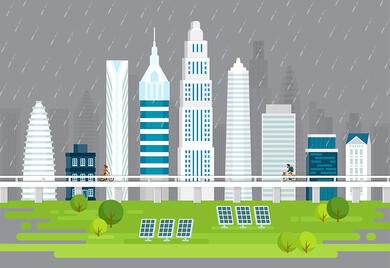
3 Myths about Public Private Partnerships
People newly engaged with PPPs often hold strong beliefs about them. Some of them are just plain wrong.

Four challenges facing the buildings of the future
In the 1960s, the Jetsons showed us a futuristic city in which pollution and the use of non-renewable resources did not exist. Twenty years later, when we had already begun to hear about environmental problems, Blade Runner showed us a more pessimistic vision of 2019: a city with countless skyscrapers, over-population, and extremely high pollution levels. Today we already have much of the Jetson’s smart technology, but sustainable buildings are needed to avoid Ridley Scott’s dystopian city. In 2016, the New Climate Economy determined that the only way to grow in the future and address the current gap is with sustainable infrastructure. According to the Inter-American Development Bank (IDB) and Mercer study “Crossing the Bridge to Sustainable Infrastructure Investing. Exploring Ways to Make it Across,” the ability to develop buildings of this kind depends on overcoming at least four key challenges: 1. Lack of familiarity What is sustainable infrastructure? Many investors still lack the information they need to clearly identify what it is and what it is not, and to identify the nature of the business opportunity. This makes it difficult to increase this type of construction. Sustainable infrastructure is planned, constructed, and operated to comply with changing governance, social, environmental, economic, and financial standards over time. For this reason, the role of multilateral and governmental organizations is to educate, inform, and provide appropriate financial products, in order to adapt current businesses to a climate change resilient economy with low carbon emissions. 2. Limited standardization of tools and approaches As this is a megatrend in full swing, there is excessive fragmentation in sustainability standards, principles, and initiatives. In addition, there is a lack of adequate information available on what the environmental, social, and governance criteria are for companies not listed in their respective securities markets, making it difficult for investors to identify which projects are sustainable. In addition, the lack of information increases transaction costs. For this reason, the IDB Group is developing and promoting the adoption of harmonized principles and working with investors to facilitate discussions regarding currently existing barriers to sustainable infrastructure. The objective is to generate useful solutions with innovative financial instruments in local markets and public-private partnerships and concessions that facilitate private sector participation. [clickToTweet tweet="US$6 trillion investment in sustainable infrastructure per year requires #Latam and the #Caribbean" quote="US$6 trillion investment in sustainable infrastructure per year requires Latin America and the Caribbean" theme="style1"] 3. Lack of coordinated policy Another fundamental point is to have consistent regulations and a commitment to comply with them throughout the region and in all sectors. Following guidelines like the Paris Agreement and the United Nations Sustainable Development Goals is key to maintaining investors’ interest in measures such as the adoption of clean energy. For Latin America and the Caribbean, it is essential to adopt instruments adapted to our reality. In this case, the IDB Group’s NDC Invest is a solution enabling countries to implement these guidelines through a simple platform for preparing sustainable and bankable project portfolios, and increasing access to concessional funds, among other benefits. 4. Lack of tools and focus on climate resilience To date, priority has not been given to how climate change adaptation should be achieved, both in terms of infrastructure and the financial tools for investing in it. However, today there are various financial tools for adapting to climate change. For example, IDB Invest (formerly known as Inter-American Investment Corporation) has mixed climate financing instruments that can be used to address these challenges and adopt climate change resilient modalities with low carbon emissions. Developing the construction of the future requires investing at least US$6 trillion per year in sustainable infrastructure for our region. This will make it possible to support the economic development of Latin America and the Caribbean, grow at the necessary pace, and prevent our cities from becoming futuristic dystopias. Subscribe to receive more content like this! [mc4wp_form]
What can Latin America and the Caribbean learn from Silicon Valley
In 1984, Steve Jobs launched the first Mac. The classic film “Revenge of the Nerds” was released the same year. At the time, computers and nerds went hand in hand. During my adolescence, the impression of what seemed to be happening in Silicon Valley was “not cool.” In recent decades, the area that stretches to the south of San Francisco has become the undisputed pole of innovation worldwide. Many countries have tried to develop their own versions of Silicon Valley, but for most of them this is an elusive goal. Silicon Valley is a unique ecosystem, thanks to the clustering of the top technology companies, universities closely linked to the subject, innovation laboratories, and a very extensive private equity industry. But what really makes this valley unique is its entrepreneurial culture. They take risks, learn from their failures, and always think big: growing 10 times and not by 10%. In his recent annual letter to Amazon’s shareholders, Jeff Bezos emphasizes the importance of having an obsessive customer focus. Bezos explains how machine learning and artificial intelligence impact almost all areas of his company. Above all, he highlights the enormous risk of becoming irrelevant if they get stuck on internal processes, if they don’t make quick decisions, and they don’t adapt to major trends. In summary, the letter is a manifesto to the Silicon Valley culture, an exponential vision of the future. The Silicon Valley recipe: New business models Last June, the directors of the Inter-American Development Bank (IDB) and the staff of IDB Invest (formerly known as Inter-American Investment Corporation) spent three days in Silicon Valley, for their first joint trip. The intense agenda included several of the most emblematic technology companies, incubators, accelerators, risk equity funds, and think tanks. Some of the most mentioned technologies were the Internet of Things, artificial intelligence, blockchain, robotics, 3D printing, virtual reality, and augmented reality. However, beyond its inventions, Silicon Valley is well-known for mainstreaming new business models. In many cases, these models have changed complete paradigms, such as the economy “uberization” and the crowdfunding. Ultimately, Silicon Valley is the window from which we glimpse the changes that will impact all areas of our lives, from our work, home, cities, and transportation to our finances, health, education, and entertainment. Computer processing costs continue to fall, so we should expect disruptive changes in every industry exposed to technology. This means nearly all industries! Silicon Valley's key for Latin America and the Caribbean Upon our return, we had many questions about Latin America and the role of development banking: What are the major development challenges emerging from these technological changes? How can we prepare to buffer the imminent impact that the most vulnerable will suffer? What kind of knowledge should we generate and how should we disseminate it? How can we ensure that regulations and laws (that by nature move more slowly than technology) favor innovation, efficiency, and inclusion? How can we deepen support for the Latin American entrepreneur? In the ICT (Information and Communications Technology) industry it is essential to support, in public and private spheres, investments in broadband in a region that has consistently under-invested in infrastructure. Mobile broadband is the great facilitator of the technology ecosystem and the great democratizer of the twenty-first century. Networks must be ubiquitous and costs need to be accessible. It is important to promote competition and entrepreneurship, and prevent market concentration. During 2017, IDB Invest has contributed to this goal/effort with loans to Telecom Personal in Argentina and to Tigo in Paraguay. Despite this, development banking must be more ambitious. In a world that is accelerating at great speed, banking must lead by looking forward and not in the rear-view mirror. The recipes from the past do not work when we are facing paradigm changes. The quantity of data circulating on the Internet doubles every year and a half. Currently, more content and information is generated per day than what was generated in entire centuries during the pre-digital age. Using landline phones, we took more than 100 years to connect all households. With cell phones, we connected nearly everyone in less than 20 years. And now, Dell, IDC, and others expect that by 2020 there will be between 30 billion and 50 billion objects connected to the Internet, helping in turn to provide feedback for machine learning and artificial intelligence. Much has changed since the release of “Revenge of the Nerds.” Now, in Silicon Valley, nerds are cool: they work in jeans and sandals, get around on skates and colored bicycles, they relax on beanbags, and are offered free meals, 24/7. In many cases, their bank accounts feature a lot of zeros, which is not surprising since the five companies with the greatest market capitalization in the world are Apple, Alphabet, Microsoft, Amazon, and Facebook. The nerds have in fact had their revenge! Subscribe to receive more content like this! [mc4wp_form]

How can we boost sustainable infrastructure investments?
Evidence is mounting that through the right mix of policies and incentives the world can significantly reduce climate risks while boosting growth. Last month, the Organisation for Economic Co-operation and Development (OECD) said that action on climate change can generate inclusive economic growth over both the short and long term. These policies can increase GDP by up to 2.8% on average across the G20 countries in 2050. The question is, how can we capitalize on these opportunities while reducing climate risk? We believe that the answer is joining forces from governments, multilateral development banks and investors to increase investments in sustainable infrastructure.

Latin America needs more broadband to capitalize on the data explosion
There are many stories about the origins of chess. To me, the most colorful is about a king in India who was given a new game consisting of two armies and 64 squares, to overcome the loss of a son in the battlefield. The king was so delighted with this new game that he offered to give the inventor anything he wished for as compensation: “Give me one grain of rice for the first square, two grains for the second square, four grains for the third square, and so on for each of the squares of the game board,” said the inventor.

This is the Time to Push Social Infrastructure in Latin America and the Caribbean
Discussions about investment in transport infrastructure as a recipe to get out of the crisis have become a cliché. But there's not so much talk about investment in social infrastructure, focused on sectors such as health or education, which also creates large multiplier effects.